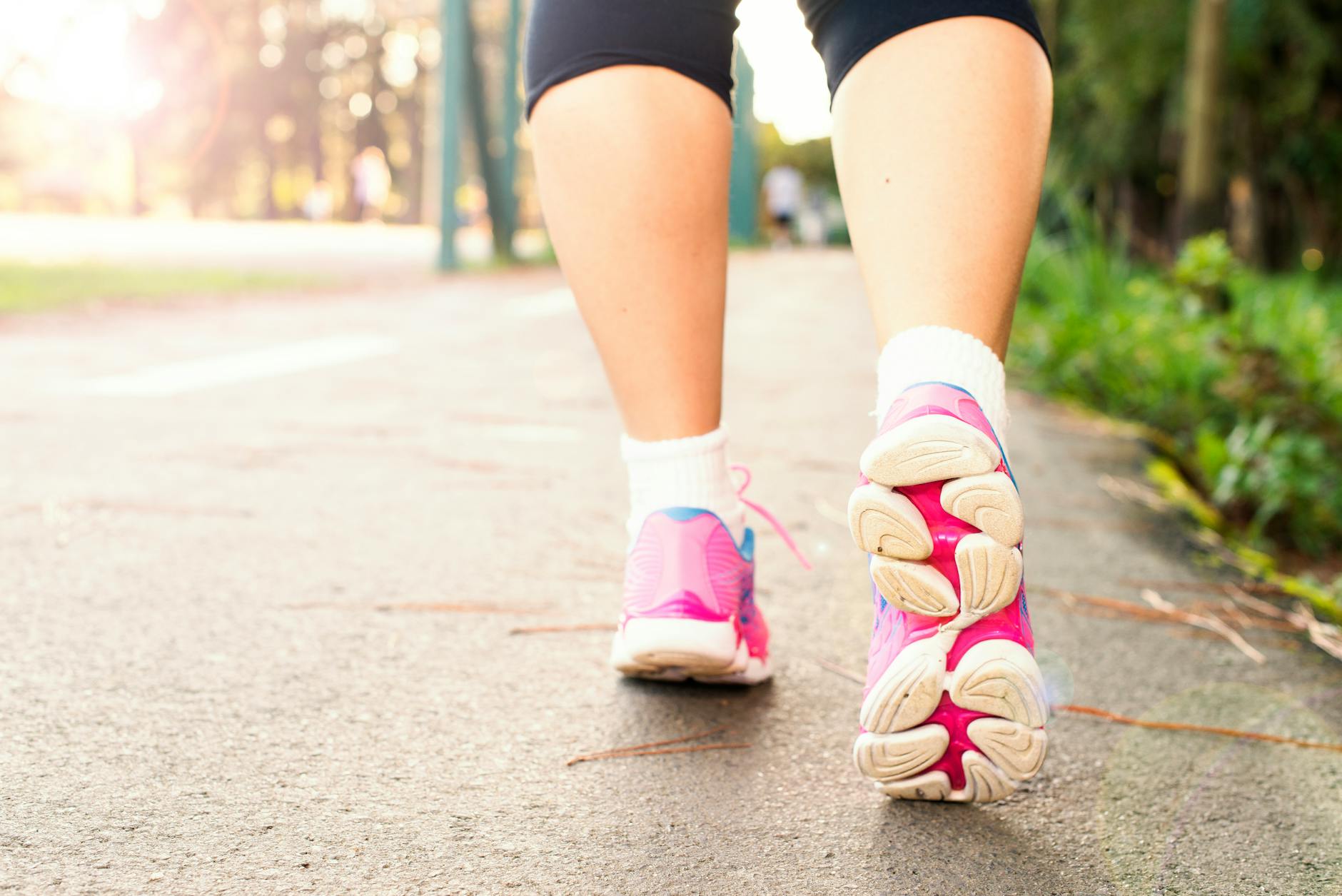Continue reading to discover more about these two workouts, such as the differences between walking and running in terms of weight loss and calories expended, as well as the advantages of walking on an elevation over running.
It’s Monday morning, the alarm goes off, and it’s already 7:30 a.m., but you’re 30 minutes late. Normally, it takes 45 minutes to walk the three kilometers to work, but this morning, you’ll run for 20 minutes. Yes, but by midday, you’re tired and feel like you’ve expended more energy than usual on the trip. Nonetheless, you’ve covered the same distance as on previous days. How could this be?
The calorie consumption associated with any activity is known as the “metabolic cost,” and it relates to the energy required by our organs to reach a particular distance. This metabolic cost may be calculated by measuring the oxygen our bodies eat and the carbon dioxide they emit. This allows us to estimate the quantity of energy expended and, consequently, the metabolic cost. Researchers used this strategy to solve our question back in the 1970s.
Perhaps unsurprisingly, running requires more energy than walking for the same distance. But why?

Energy Loss during running
Imagine you are watching someone sprint. Examine the vertical mobility (up and down) of their pelvis and head. When we run, our bodies move a greater distance up and down than when we walk.
To achieve this vertical movement, the muscles of the lower limbs must exert more power, which consumes more energy but does not bring us any closer to our goal. So, when we run, some of the energy we consume is used to propel our bodies upward rather than forward. Running requires more energy to cover those three kilometers than walking does.
The distinction between walking and running extends beyond the exercise itself. Indeed, any physical exertion results in delayed expenditure of energy, which is added to the expenditure during the activity.
Taking this into consideration, running consumes more energy than walking. Immediately following your 3 km run, the higher energy consumption (relative to resting) lasts several minutes, owing to an increase in body temperature and the replenishment of energy reserves. Because of the intensity difference between the two exercises, the extra expenditure after running is more than double that recorded after walking.
Everything depends on the speed.
Running, therefore, requires a larger calorie expenditure than walking for the same distance covered. However, this is only applicable if the walking speed is considered “normal” (about 5 kilometers per hour). So, if we walk slowly, it will take us longer to traverse the 3 km, resulting in a higher calorie expenditure in the end. This is because the body expends a constant amount of energy per unit of time, regardless of the activity (known as the “basal metabolic rate”).
The same is true if the walking speed is extremely high (greater than 8 km/h): running is more energy-efficient. The coordination required to walk at such a fast speed requires us to utilize our muscles more, as we cannot take advantage of the suppleness of our tendons as we can when running.
Furthermore, we have a highly exact intuitive sense of the energy efficiency of a specific type of movement. If we’re on a treadmill with a gradually increasing speed, the point at which we spontaneously transition from walking to running corresponds to the point at which walking becomes more energy-consuming than running.
Finally, because of the greater center of mass oscillation and increased energy expenditure after exercise, running to work is more energy-intensive than walking the same distance. But remember, whether you walk or run to work, the most important thing is that you are already conserving energy!
Walking vs. Running: Benefits and Considerations
Exercise has numerous benefits for one’s physical, mental, and emotional wellbeing. However, there isn’t much of a difference between running and walking: both boost your overall health, and neither exercise is necessarily superior to the other. Consider your personal goals while determining whether to run or stroll.
If you want to finish a race or burn the most calories, running may be the best option; however, walking delivers important health advantages and is a low-impact activity that is ideal for persons with arthritis, knee discomfort, or other health issues.
Benefits of Cardio Exercise
Cardiovascular exercise is a movement that increases your heart rate and causes you to breathe more deeply than usual. There are numerous benefits of cardio, including:
- Longer lifespan
- Lower blood pressure.
- Reduced risk of cardiovascular disease.
- Better sleep.
- Better mental health.
- Decreased body fat
- Enhanced immune system function.
Because there are so many benefits, the Centers for Disease Control and Prevention recommends that individuals engage in 150 minutes of moderate exercise per week, such as walking. Alternatively, aim for 75 minutes of intense activity, such as running or walking.

Benefits of Running
Running allows you to complete your prescribed exercise in around half the time, making it an excellent choice for those with limited time. Running may also be a smart alternative if you want to finish a race or improve your speed and agility on the sports field.
Running provides all of the benefits of cardiovascular exercise mentioned above, as well as:
A longer life span: According to one study, runners live three years longer on average than non runners.
Increased calorie burn: Running burns roughly double the calories per minute than walking.
Stronger bones: Research indicates that runners have stronger bones compared to those who walk for exercise.
Benefits of Walking
Walking has the benefits of cardiovascular activities stated above, as well as these perks:
It’s accessible. Most people can walk without any specialized training or equipment. Walking is often simple to begin, especially for those with lower fitness levels or mobility issues.
It can lessen cravings. According to studies, taking a 15-minute walk reduces the likelihood of craving chocolate.
Walking has been shown to reduce arthritis-related joint discomfort.
It can lower the genetic risk of obesity: According to one study, persons who walked regularly had their obesity-related genes reduced by half.
Which is better, walking or running?
Neither is necessarily better than the other. Which option is best for you will be determined by your goals and preferred activities.
Walking and running are both beneficial to one’s physical and mental wellbeing. They allow you to exercise without the need for specific equipment, provide you time in nature (which has additional health advantages), and provide social chances if you walk with a friend or participate in races with a group.
If you enjoy high-intensity exercise, running may be a good fit for you. Running causes you to burn more calories per minute, potentially leading to faster weight loss. According to one study, while both running and walking promote weight loss, persons who ran lost more weight than those who walked.
Walking is an excellent choice for those who are just getting started with their exercise program. Most folks can walk, which is an excellent method to begin exercising. Because it is low-impact and less intensive than running, it is an excellent place to begin.
Running burns more calories per minute than walking. However, walking too burns a lot of calories and can help with weight loss and control over time.
Risks of Running
Running is a high-impact, strenuous exercise; hence, it has a greater risk than walking, including:
- Achilles’ tendonitis
- Shin splints
- Blisters
- Muscle strains
- Knee discomfort
To avoid injury while jogging, start slowly and gradually increase your distance and speed.
Increase the Intensity of Walking
If you’re already walking and want to enhance the intensity of your workouts, you have more options than just running. These changes can help you boost up your workout without running.
Walk along an incline: Walking uphill or elevation will significantly increase your calorie expenditure and exertion. Walking at a 10% slope will burn twice as many calories as walking on a flat surface.

Wear a weighted vest or backpack: Walking with additional weight burns more calories and requires more effort. Try rucking, a popular low-impact workout involving walking with a weighted rucksack.
Increase your speed: Power walking provides a more rigorous workout than a stroll.
To Conclude
Walking and running are effective ways to decrease weight and enhance overall health. Cardiovascular activities like these can benefit both your physical and mental wellbeing. Running burns more calories per minute, however walking is more accessible and involves fewer dangers.
Walking at an elevation or with a weighted backpack can help you burn more calories. Remember that moving is one of the most important things you can do for your health, whether you walk, jog, or run.
